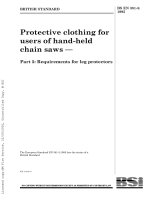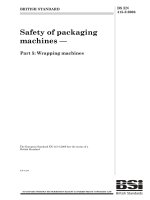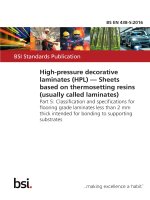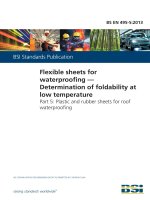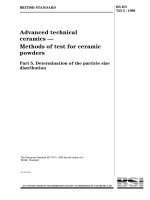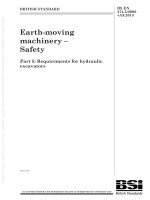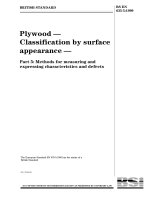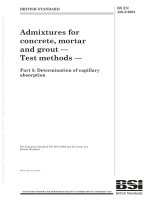Bsi bs en 61158 5 23 2014
Bạn đang xem bản rút gọn của tài liệu. Xem và tải ngay bản đầy đủ của tài liệu tại đây (3.52 MB, 94 trang )
BS EN 61158-5-23:2014
BSI Standards Publication
Industrial communication
networks — Fieldbus
specifications
Part 5-23: Application layer service
definition — Type 23 elements
BRITISH STANDARD
BS EN 61158-5-23:2014
National foreword
This British Standard is the UK implementation of EN 61158-5-23:2014. It is
identical to IEC 61158-5-23:2014.
The UK participation in its preparation was entrusted to Technical
Committee AMT/7, Industrial communications: process measurement and
control, including fieldbus.
A list of organizations represented on this committee can be obtained on
request to its secretary.
This publication does not purport to include all the necessary provisions of
a contract. Users are responsible for its correct application.
© The British Standards Institution 2014.
Published by BSI Standards Limited 2014
ISBN 978 0 580 79464 3
ICS 25.040.40; 35.100.70; 35.110
Compliance with a British Standard cannot confer immunity from
legal obligations.
This British Standard was published under the authority of the
Standards Policy and Strategy Committee on 31 October 2014.
Amendments issued since publication
Date
Text affected
BS EN 61158-5-23:2014
EUROPEAN STANDARD
EN 61158-5-23
NORME EUROPÉENNE
EUROPÄISCHE NORM
October 2014
ICS 25.040.40; 35.100.70; 35.110
English Version
Industrial communication networks - Fieldbus specifications Part 5-23: Application layer service definition - Type 23 elements
(IEC 61158-5-23:2014)
Réseaux de communication industriels - Spécifications des
bus de terrain - Partie 5-23: Définition des services de la
couche application - Éléments de type 23
(CEI 61158-5-23:2014)
Industrielle Kommunikationsnetze - Feldbusse Teil 5-23: Dienstfestlegungen des Application Layer
(Anwendungsschicht) - Typ 23-Elemente
(IEC 61158-5-23:2014)
This European Standard was approved by CENELEC on 2014-09-22. CENELEC members are bound to comply with the CEN/CENELEC
Internal Regulations which stipulate the conditions for giving this European Standard the status of a national standard without any alteration.
Up-to-date lists and bibliographical references concerning such national standards may be obtained on application to the CEN-CENELEC
Management Centre or to any CENELEC member.
This European Standard exists in three official versions (English, French, German). A version in any other language made by translation
under the responsibility of a CENELEC member into its own language and notified to the CEN-CENELEC Management Centre has the
same status as the official versions.
CENELEC members are the national electrotechnical committees of Austria, Belgium, Bulgaria, Croatia, Cyprus, the Czech Republic,
Denmark, Estonia, Finland, Former Yugoslav Republic of Macedonia, France, Germany, Greece, Hungary, Iceland, Ireland, Italy, Latvia,
Lithuania, Luxembourg, Malta, the Netherlands, Norway, Poland, Portugal, Romania, Slovakia, Slovenia, Spain, Sweden, Switzerland,
Turkey and the United Kingdom.
European Committee for Electrotechnical Standardization
Comité Européen de Normalisation Electrotechnique
Europäisches Komitee für Elektrotechnische Normung
CEN-CENELEC Management Centre: Avenue Marnix 17, B-1000 Brussels
© 2014 CENELEC All rights of exploitation in any form and by any means reserved worldwide for CENELEC Members.
Ref. No. EN 61158-5-23:2014 E
BS EN 61158-5-23:2014
EN 61158-5-23:2014
-2-
Foreword
The text of document 65C/763/FDIS, future edition 1 of IEC 61158-5-23, prepared by
SC 65C “Industrial networks” of IEC/TC 65 “Industrial-process measurement, control and automation"
was submitted to the IEC-CENELEC parallel vote and approved by CENELEC as
EN 61158-5-23:2014.
The following dates are fixed:
•
latest date by which the document has to be
implemented at national level by
publication of an identical national
standard or by endorsement
(dop)
2015-06-22
•
latest date by which the national
standards conflicting with the
document have to be withdrawn
(dow)
2017-09-22
Attention is drawn to the possibility that some of the elements of this document may be the subject of
patent rights. CENELEC [and/or CEN] shall not be held responsible for identifying any or all such
patent rights.
This document has been prepared under a mandate given to CENELEC by the European Commission
and the European Free Trade Association.
Endorsement notice
The text of the International Standard IEC 61158-5-23:2014 was approved by CENELEC as a
European Standard without any modification.
In the official version, for Bibliography, the following notes have to be added for the standards indicated:
IEC 61784-1
NOTE
Harmonized as EN 61784-1.
IEC 61784-2
NOTE
Harmonized as EN 61784-2.
BS EN 61158-5-23:2014
EN 61158-5-23:2014
-3-
Annex ZA
(normative)
Normative references to international publications
with their corresponding European publications
The following documents, in whole or in part, are normatively referenced in this document and are
indispensable for its application. For dated references, only the edition cited applies. For undated
references, the latest edition of the referenced document (including any amendments) applies.
NOTE 1 When an International Publication has been modified by common modifications, indicated by (mod), the relevant
EN/HD applies.
NOTE 2 Up-to-date information on the latest versions of the European Standards listed in this annex is available here:
www.cenelec.eu
Publication
Year
Title
EN/HD
Year
IEC 61158-1
2014
Industrial communication networks Fieldbus specifications Part 1: Overview and guidance for the
IEC 61158 and IEC 61784 series
EN 61158-1
2014
IEC 61158-6
Series
Industrial communication networks Fieldbus specifications Part 6: Application layer protocol
specification
EN 61158-6
Series
ISO/IEC 646
-
Information technology - ISO 7-bit coded
character set for information interchange
-
-
ISO/IEC 7498-1
-
Information technology - Open Systems
Interconnection - Basic reference model:
The basic model
-
-
ISO/IEC 8822
-
Information technology - Open Systems
Interconnection - Presentation service
definition
-
-
ISO/IEC 8824-1
-
Information technology - Abstract Syntax
Notation One (ASN.1): Specification of
basic notation
-
-
ISO/IEC 9545
-
Information technology - Open Systems
Interconnection - Application layer
structure
-
-
ISO/IEC 10731
-
Information technology - Open Systems
Interconnection - Basic Reference Model Conventions for the definition of OSI
services
-
–2–
BS EN 61158-5-23:2014
IEC 61158-5-23:2014 © IEC 2014
CONTENTS
INTRODUCTION ..................................................................................................................... 6
1
Scope ............................................................................................................................... 7
2
1.1 General ................................................................................................................... 7
1.2 Specifications .......................................................................................................... 8
1.3 Conformance ........................................................................................................... 8
Normative references ....................................................................................................... 8
3
Terms, definitions, symbols, abbreviated terms and conventions ...................................... 9
4
3.1 Referenced terms and definitions ............................................................................ 9
3.2 Type 23 specific terms and definitions ................................................................... 10
3.3 Symbols and abbreviated terms............................................................................. 12
3.4 Conventions .......................................................................................................... 13
Concept .......................................................................................................................... 16
5
Data type ASE ................................................................................................................ 16
6
5.1 Overview ............................................................................................................... 16
5.2 Fixed length types ................................................................................................. 16
Communication model specification ................................................................................ 21
6.1 Communication model ........................................................................................... 21
6.2 ASE....................................................................................................................... 23
6.3 AR type C .............................................................................................................. 58
6.4 AR type F .............................................................................................................. 71
Bibliography .......................................................................................................................... 90
Figure 1 – Cyclic model (n:n type distributed shared memory, unconfirmed push model) ...... 22
Figure 2 – Cyclic model (1:n type distributed shared memory, unconfirmed push model) ...... 22
Figure 3 – Transient model (Client server model) .................................................................. 22
Figure 4 – Transient model (Push model).............................................................................. 23
Figure 5 – Structure of ASE type C of FAL type 23 ............................................................... 23
Figure 6 – Structure of ASE type F of FAL type 23 ................................................................ 23
Figure 7 – Structure of AR type C ......................................................................................... 58
Figure 8 – Structure of AR type F.......................................................................................... 71
Table 1 – Ld service parameters ........................................................................................... 25
Table 2 – Set service parameters ......................................................................................... 25
Table 3 – Reset service parameters ...................................................................................... 25
Table 4 – Read service parameters....................................................................................... 26
Table 5 – Write service parameters ....................................................................................... 26
Table 6 – Ld service parameters ........................................................................................... 27
Table 7 – Set service parameters ......................................................................................... 28
Table 8 – Reset service parameters ...................................................................................... 28
Table 9 – Read service parameters....................................................................................... 29
Table 10 – Write service parameters ..................................................................................... 29
Table 11 – Ld service parameters ......................................................................................... 31
Table 12 – Set service parameters ........................................................................................ 32
BS EN 61158-5-23:2014
IEC 61158-5-23:2014 © IEC 2014
–3–
Table 13 – Reset service parameters .................................................................................... 32
Table 14 – Read service parameters ..................................................................................... 32
Table 15 – Write service parameters ..................................................................................... 33
Table 16 – Get memory access info service parameters ....................................................... 36
Table 17 – Run service parameters....................................................................................... 37
Table 18 – Stop service parameters ...................................................................................... 37
Table 19 – Read memory service parameters ....................................................................... 38
Table 20 – Write memory service parameters ....................................................................... 39
Table 21 – Get memory access info service parameters ....................................................... 41
Table 22 – Run service parameters....................................................................................... 42
Table 23 – Stop service parameters ...................................................................................... 43
Table 24 – Read memory service parameters ....................................................................... 44
Table 25 – Write memory service parameters ....................................................................... 45
Table 26 – Vendor command service parameters .................................................................. 46
Table 27 – Distribute node info service parameters ............................................................... 47
Table 28 – Get statistics service parameters ......................................................................... 48
Table 29 – Get node info detail service parameters .............................................................. 49
Table 30 – AC data service parameters ................................................................................ 52
Table 31 – AC data ND service parameters .......................................................................... 53
Table 32 – Get attribute service parameters ......................................................................... 54
Table 33 – Set attribute service parameters .......................................................................... 54
Table 34 – Synchronization trigger service parameters ......................................................... 56
Table 35 – Start measurement service parameters ............................................................... 57
Table 36 – Get offset service parameters .............................................................................. 58
Table 37 – Control cyclic service parameters ........................................................................ 62
Table 38 – CT Update service parameters ............................................................................ 64
Table 39 – AC Send service parameters ............................................................................... 65
Table 40 – AC Param send service parameters .................................................................... 66
Table 41 – CPD Set service parameters ............................................................................... 71
Table 42 – Control cyclic service parameters ........................................................................ 78
Table 43 – CT Update service parameters ............................................................................ 80
Table 44 – AC Send service parameters ............................................................................... 81
Table 45 – AC Send ND service parameters ......................................................................... 82
Table 46 – Synchronous trigger internal service parameters ................................................. 86
Table 47 – Measure send service parameters ....................................................................... 87
Table 48 – MeasureAck send service parameters ................................................................. 88
Table 49 – Offset send service parameters ........................................................................... 88
Table 50 – Update send service parameters ......................................................................... 89
–6–
BS EN 61158-5-23:2014
IEC 61158-5-23:2014 © IEC 2014
INTRODUCTION
This part of IEC 61158 is one of a series produced to facilitate the interconnection of
automation system components. It is related to other standards in the set as defined by the
“three-layer” fieldbus reference model described in IEC 61158-1.
The application service is provided by the application protocol making use of the services
available from the data-link or other immediately lower layer. This standard defines the
application service characteristics that fieldbus applications and/or system management may
exploit.
Throughout the set of fieldbus standards, the term “service” refers to the abstract capability
provided by one layer of the OSI Basic Reference Model to the layer immediately above. Thus,
the application layer service defined in this standard is a conceptual architectural service,
independent of administrative and implementation divisions.
BS EN 61158-5-23:2014
IEC 61158-5-23:2014 © IEC 2014
–7–
INDUSTRIAL COMMUNICATION NETWORKS –
FIELDBUS SPECIFICATIONS –
Part 5-23: Application layer service definition –
Type 23 elements
1
1.1
Scope
General
The fieldbus Application Layer (FAL) provides user programs with a means to access the
fieldbus communication environment. In this respect, the FAL can be viewed as a “window
between corresponding application programs.”
This standard provides common elements for basic time-critical and non-time-critical
messaging communications between application programs in an automation environment and
material specific to Type 12 fieldbus. The term “time-critical” is used to represent the
presence of a time-window, within which one or more specified actions are required to be
completed with some defined level of certainty. Failure to complete specified actions within
the time window risks failure of the applications requesting the actions, with attendant risk to
equipment, plant and possibly human life.
This standard defines in an abstract way the externally visible service provided by the
different Types of the fieldbus Application Layer in terms of
a) an abstract model for defining application resources (objects) capable of being
manipulated by users via the use of the FAL service,
b) the primitive actions and events of the service;
c) the parameters associated with each primitive action and event, and the form which they
take; and
d) the interrelationship between these actions and events, and their valid sequences.
The purpose of this standard is to define the services provided to
a) the FAL user at the boundary between the user and the Application Layer of the Fieldbus
Reference Model, and
b) Systems Management at the boundary between the Application Layer and Systems
Management of the Fieldbus Reference Model.
This standard specifies the structure and services of the IEC fieldbus Application Layer, in
conformance with the OSI Basic Reference Model (ISO/IEC 7498-1) and the OSI Application
Layer Structure (ISO/IEC 9545).
FAL services and protocols are provided by FAL application-entities (AE) contained within the
application processes. The FAL AE is composed of a set of object-oriented Application
Service Elements (ASEs) and a Layer Management Entity (LME) that manages the AE. The
ASEs provide communication services that operate on a set of related application process
object (APO) classes. One of the FAL ASEs is a management ASE that provides a common
set of services for the management of the instances of FAL classes.
Although these services specify, from the perspective of applications, how request and
responses are issued and delivered, they do not include a specification of what the requesting
and responding applications are to do with them. That is, the behavioral aspects of the
applications are not specified; only a definition of what requests and responses they can
–8–
BS EN 61158-5-23:2014
IEC 61158-5-23:2014 © IEC 2014
send/receive is specified. This permits greater flexibility to the FAL users in standardizing
such object behavior. In addition to these services, some supporting services are also defined
in this standard to provide access to the FAL to control certain aspects of its operation.
1.2
Specifications
The principal objective of this standard is to specify the characteristics of conceptual
application layer services suitable for time-critical communications, and thus supplement the
OSI Basic Reference Model in guiding the development of application layer protocols for timecritical communications.
A secondary objective is to provide migration paths from previously-existing industrial
communications protocols. It is this latter objective which gives rise to the diversity of services
standardized as the various Types of IEC 61158, and the corresponding protocols
standardized in subparts of IEC 61158-6.
This specification may be used as the basis for formal Application Programming-Interfaces.
Nevertheless, it is not a formal programming interface, and any such interface will need to
address implementation issues not covered by this specification, including
a) the sizes and octet ordering of various multi-octet service parameters, and
b) the correlation of paired request and confirm, or indication and response, primitives.
1.3
Conformance
This standard does not specify individual implementations or products, nor does it constrain
the implementations of application layer entities within industrial automation systems.
There is no conformance of equipment to this application layer service definition standard.
Instead, conformance is achieved through implementation of conforming application layer
protocols that fulfill any given Type of application layer services as defined in this standard.
2
Normative references
The following documents, in whole or in part, are normatively referenced in this document and
are indispensable for its application. For dated references, only the edition cited applies. For
undated references, the latest edition of the referenced document (including any
amendments) applies.
NOTE All parts of the IEC 61158 series, as well as IEC 61784-1 and IEC 61784-2 are maintained simultaneously.
Cross-references to these documents within the text therefore refer to the editions as dated in this list of normative
references.
IEC 61158-1:2014, Industrial communication networks – Fieldbus specifications – Part 1:
Overview and guidance for the IEC 61158 and IEC 61784 series
IEC 61158-6 (all parts), Industrial communication networks – Fieldbus specifications – Part 6:
Application layer protocol specification
ISO/IEC 646, Information technology – ISO 7–bit coded character set for information
interchange
ISO/IEC 7498-1, Information technology – Open Systems Interconnection – Basic Reference
Model: The Basic Model
ISO/IEC 8822, Information technology – Open Systems Interconnection – Presentation
service definition
BS EN 61158-5-23:2014
IEC 61158-5-23:2014 © IEC 2014
ISO/IEC 8824-1, Information
Specification of basic notation
technology
–9–
–
Abstract
Syntax
Notation
One
(ASN.1):
ISO/IEC 9545, Information technology – Open Systems Interconnection – Application Layer
structure
ISO/IEC 10731, Information technology – Open Systems Interconnection – Basic Reference
Model – Conventions for the definition of OSI services
3
Terms, definitions, symbols, abbreviated terms and conventions
For the purposes of this document, the following terms, definitions, symbols, abbreviations
and conventions apply.
3.1
Referenced terms and definitions
3.1.1
ISO/IEC 7498-1 terms
For the purposes of this document, the following terms given in ISO/IEC 7498-1 apply:
a) application entity
b) application process
c) application protocol data unit
d) application service element
e) application entity invocation
f)
application process invocation
g) application transaction
h) real open system
i)
transfer syntax
3.1.2
ISO/IEC 8822 terms
For the purposes of this document, the following terms given in ISO/IEC 8822 apply:
a) abstract syntax
b) presentation context
3.1.3
ISO/IEC 9545 terms
For the purposes of this document, the following terms given in ISO/IEC 9545 apply:
a) application-association
b) application-context
c) application context name
d) application-entity-invocation
e) application-entity-type
f)
application-process-invocation
g) application-process-type
h) application-service-element
i)
application control service element
3.1.4
ISO/IEC 8824-1 terms
For the purposes of this document, the following terms given in ISO/IEC 8824-1 apply:
– 10 –
BS EN 61158-5-23:2014
IEC 61158-5-23:2014 © IEC 2014
a) object identifier
b) type
3.1.5
IEC 61158-1 terms
For the purposes of this document, the following terms given in IEC 61158-1 apply:
a) DLL mapping protocol machine
b) fieldbus application layer
c) FAL service protocol machine
d) protocol data unit
3.2
Type 23 specific terms and definitions
For the purposes of this document, the following terms and definitions apply.
3.2.1
cyclic transmission
transmission that is performed periodically used for the link device update
3.2.2
intelligent device station
node capable of performing 1:n bit data and word data cyclic transmission and transient
transmission with the master station, and transient transmission with slave stations, excluding
remote I/O stations and having client functions and server functions during transient
transmission
3.2.3
link bit
link relay bit data that are shared by all the nodes through the cyclic transmission and is used
as one bit unit shared memory of the n:n type
3.2.4
link device
link bit, link word, link x and link y or RX, RY, RWr, and RWw
3.2.5
link word
link register two octet unit data that are shared by all the nodes through the cyclic
transmission and is used as two octet unit shared memory of the n:n type
3.2.6
link x
link input received bit data that are transmitted from each node through the cyclic
transmission and is used as an input shared memory of the 1:n type
3.2.7
link y
link output bit data that are sent to each node through the cyclic transmission and is used as
an output shared memory of the 1:n type
3.2.8
local station
node capable of performing n:n bit data and word data cyclic transmission and transient
transmission with the master station and other local stations, and transient transmission with
slave stations, excluding remote I/O stations and having server functions and client functions
during transient transmission
BS EN 61158-5-23:2014
IEC 61158-5-23:2014 © IEC 2014
– 11 –
3.2.9
management node
node in which parameters are set
3.2.10
master station
node that has control information (parameters) and manages cyclic transmission
3.2.11
node
element that forms a network and performs data transmission, reception, and transfer
3.2.12
node-to-node test
physical layer test between two nodes
3.2.13
normal node
node other than a management node
3.2.14
remote device station
node capable of performing 1:n bit data and word data cyclic transmission and transient
transmission with the master station, and transient transmission with slave stations, excluding
remote I/O stations and having server functions during transient transmission
3.2.15
remote I/O station
node capable of performing 1:n bit data cyclic transmission with the master station
3.2.16
reserve node
node that is not yet connected, but counted in the total node number of the network not
performing cyclic transmission, but always regarded as normal from applications
3.2.17
RX
remote input as viewed from the master station with bit data that are periodically updated by
cyclic transmission, salve to master, or in local station as viewed from the master station is
RY of the local station
3.2.18
RY
remote output as viewed from the master station with bit data that are periodically updated by
cyclic transmission, master to salve, or in local station as viewed from the master station is
RX of the local station
3.2.19
RWr
remote register (input) as viewed from the master station with word data that are periodically
updated by cyclic transmission, slave to master, or in local station as viewed from the master
station is RWw of the local station
3.2.20
RWw
remote register (output) as viewed from the master station with word data that are periodically
updated by cyclic transmission, master to slave, or in local station as viewed from the master
station is RWr of the local station
– 12 –
BS EN 61158-5-23:2014
IEC 61158-5-23:2014 © IEC 2014
3.2.21
slave station
node other than the master station
3.2.22
station
node
3.2.23
synchronization manager
node (master station role with one existing per network) that manages synchronization,
distributing synchronization timing to other nodes
3.2.24
transient transmission
transmission that is performed upon each request
3.2.25
transient transmission client function
function that issues a transient request
3.2.26
transient transmission server function
function that receives a transient request and issues a response
3.2.27
transmission control manager
node (master station role with one existing per network) that performs token passing
management
3.2.28
word
unit representing data, 16 bits in length
3.3
Symbols and abbreviated terms
AE
Application Entity
AL
Application Layer
AP
Application Process
APDU
Application Protocol Data Unit
APO
Application Process Object
AR
Application Relationship
AREP
Application Relationship Endpoint
ASE
Application Service Element
ASN.1
Abstract Syntax Notation 1
CRC
Cyclic Redundancy Check
DLL
Data-link Layer
DMPM
DLL Mapping Protocol Machine
FAL
Fieldbus Application Layer
FSPM
FAL Service Protocol Machine
LB
Link Bit
LSB
Least Significant Bit
LW
Link Word
LX
Link X
BS EN 61158-5-23:2014
IEC 61158-5-23:2014 © IEC 2014
LY
Link Y
MSB
Most Significant Bit
OSI
Open Systems Interconnection
PDU
Protocol Data Unit
3.4
– 13 –
Conventions
3.4.1
General conventions
This standard uses the descriptive conventions given in ISO/IEC 10731.
The service model, service primitives, and time-sequence diagrams used are entirely abstract
descriptions; they do not represent a specification for implementation.
Service primitives, used to represent service user/service provider interactions (see
ISO/IEC 10731), convey parameters that indicate information available in the user/provider
interaction.
This standard uses a tabular format to describe the component parameters of the service
primitives. The parameters that apply to each group of service primitives are set out in tables
throughout the remainder of this standard. Each table consists of up to five columns,
containing the name of the service parameter, and a column each for those primitives and
parameter-transfer directions used by the service:
–
the request primitive’s input parameters;
–
the indication primitive’s output parameters;
–
the response primitive’s input parameters; and
–
the confirm primitive’s output parameters.
NOTE The request, indication, response and confirm primitives are also known as requestor.submit,
acceptor.deliver, acceptor.submit, and requestor.deliver primitives, respectively (see ISO/IEC 10731).
One parameter (or part of it) is listed in each row of each table. Under the appropriate service
primitive columns, a code is used to specify the type of usage of the parameter on the
primitive and parameter direction specified in the column:
M
parameter is mandatory for the primitive.
U
parameter is a User option, and may or may not be provided depending on
the dynamic usage of the service-user. When not provided, a default value
for the parameter is assumed.
C
parameter is conditional upon other parameters or upon the environment of
the service-user.
(blank)
parameter is never present.
Some entries are further qualified by items in brackets. These may be a parameter-specific
constraint:
(=)
indicates that the parameter is semantically equivalent to the parameter in
the service primitive to its immediate left in the table.
In any particular interface, not all parameters need be explicitly stated. Some may be
implicitly associated with the primitive.
In the diagrams which illustrate these interfaces, dashed lines indicate cause-and-effect or
time-sequence relationships, and wavy lines indicate that events are roughly
contemporaneous.
– 14 –
3.4.2
BS EN 61158-5-23:2014
IEC 61158-5-23:2014 © IEC 2014
Conventions for class definitions
Class definitions are defined using templates. Each template consists of a list of attributes
and services for the class. The general form of the template is shown below:
FAL ASE:
ASE Name
CLASS:
Class Name
CLASS ID:
#
PARENT CLASS:
Parent Class Name
ATTRIBUTES:
1
(o)
Key Attribute:
numeric identifier
2
(o)
Key Attribute:
name
3
(m)
Attribute:
attribute name (values)
4
(m)
Attribute:
attribute name (values)
4.1
(s)
Attribute:
attribute name (values)
4.2
(s)
Attribute:
attribute name (values)
4.3
(s)
Attribute:
attribute name (values)
5
(c)
Constraint:
constraint expression
5.1
(m)
Attribute:
attribute name (values)
5.2
(o)
Attribute:
attribute name (values)
6
(m)
Attribute:
attribute name (values)
6.1
(s)
Attribute:
attribute name (values)
6.2
(s)
Attribute:
attribute name (values)
SERVICES:
1
(o)
OpsService:
service name
2
(c)
Constraint:
constraint expression
2.1
(o)
OpsService:
service name
3
(m)
MgtService:
service name
a) The "FAL ASE:" entry is the name of the FAL ASE that provides the services for the class
being specified.
b) The "CLASS:" entry is the name of the class being specified. All objects defined using this
template will be an instance of this class. The class may be specified by this standard, or
by a user of this standard.
c) The "CLASS ID:" entry is a number that identifies the class being specified. This number is
unique within the FAL ASE that will provide the services for this class. When qualified by
the identity of its FAL ASE, it unambiguously identifies the class within the scope of the
FAL. The value "NULL" indicates that the class cannot be instantiated. Class IDs between
1 and 255 are reserved by this standard to identify standardized classes. They have been
assigned to maintain compatibility with existing national standards. CLASS IDs between
256 and 2048 are allocated for identifying user defined classes.
d) The "PARENT CLASS:" entry is the name of the parent class for the class being specified.
All attributes defined for the parent class and inherited by it are inherited for the class
being defined, and therefore do not have to be redefined in the template for this class.
NOTE The parent-class "TOP" indicates that the class being defined is an initial class definition. The parent
class TOP is used as a starting point from which all other classes are defined. The use of TOP is reserved for
classes defined by this standard.
e) The "ATTRIBUTES" label indicate that the following entries are attributes defined for the
class.
1) Each of the attribute entries contains a line number in column 1, a mandatory (m) /
optional (o) / conditional (c) / selector (s) indicator in column 2, an attribute type label
in column 3, a name or a conditional expression in column 4, and optionally a list of
BS EN 61158-5-23:2014
IEC 61158-5-23:2014 © IEC 2014
– 15 –
enumerated values in column 5. In the column following the list of values, the default
value for the attribute may be specified.
2) Objects are normally identified by a numeric identifier or by an object name, or by both.
In the class templates, these key attributes are defined under the key attribute.
3) The line number defines the sequence and the level of nesting of the line. Each
nesting level is identified by period. Nesting is used to specify
i)
fields of a structured attribute (4.1, 4.2, 4.3),
ii) attributes conditional on a constraint statement (5). Attributes may be mandatory
(5.1) or optional (5.2) if the constraint is true. Not all optional attributes require
constraint statements as does the attribute defined in (5.2),
iii) the selection fields of a choice type attribute (6.1 and 6.2).
f)
The "SERVICES" label indicates that the following entries are services defined for the
class.
1) An (m) in column 2 indicates that the service is mandatory for the class, while an (o)
indicates that it is optional. A (c) in this column indicates that the service is conditional.
When all services defined for a class are defined as optional, at least one has to be
selected when an instance of the class is defined.
2) The label "OpsService" designates an operational service (1).
3) The label "MgtService" designates a management service (2).
4) The line number defines the sequence and the level of nesting of the line. Each
nesting level is identified by a period. Nesting within the list of services is used to
specify services conditional on a constraint statement.
3.4.3
3.4.3.1
Conventions for service definitions
General
The service model, service primitives, and time-sequence diagrams used are entirely abstract
descriptions; they do not represent a specification for implementation.
3.4.3.2
Service parameters
Service primitives are used to represent service user/service provider interactions
(ISO/IEC 10731). They convey parameters which indicate information available in the
user/provider interaction. In any particular interface, not all parameters need be explicitly
stated.
The service specifications of this standard use a tabular format to describe the component
parameters of the ASE service primitives. The parameters which apply to each group of
service primitives are set out in tables. Each table consists of up to five columns for the
a) parameter name,
b) request primitive, (transmitted from the sender)
c) indication primitive, (transmitted to the receiver)
d) response primitive, (transmitted from the receiver) and
e) confirm primitive (transmitted to the sender).
One parameter (or component of it) is listed in each row of each table. Under the appropriate
service primitive columns, a code is used to specify the type of usage of the parameter on the
primitive specified in the column:
M parameter is mandatory for the primitive.
U parameter is a User option, and may or may not be provided depending on dynamic
usage of the service user. When not provided, a default value for the parameter is
assumed.
BS EN 61158-5-23:2014
IEC 61158-5-23:2014 © IEC 2014
– 16 –
C parameter is conditional upon other parameters or upon the environment of the service
user.
— (blank) parameter is never present.
S
parameter is a selected item.
Some entries are further qualified by items in brackets. These may be
1) a parameter-specific constraint:
“(=)” indicates that the parameter is semantically equivalent to the parameter in the
service primitive to its immediate left in the table.
2) an indication that some note applies to the entry:
“(n)” indicates that the following note "n" contains additional information pertaining to
the parameter and its use.
3.4.3.3
Service procedures
The procedures are defined in terms of:
–
the interactions between application entities through the exchange of fieldbus Application
Protocol Data Units, and
–
the interactions between an application layer service provider and an application layer
service user in the same system through the invocation of application layer service
primitives.
These procedures are applicable to instances of communication between systems which
support time-constrained communications services within the fieldbus application layer.
4
Concept
The basic concept of application layer services follows IEC 61158-1, Clause 9.
The FAL defined herein has two primary deployment models. A peer-level connection based
controller network is identified throughout this FAL as type C. A master/slave oriented field
network is identified throughout this FAL as type F. Both support a distributed memory model
as well as client/server models.
5
Data type ASE
5.1
Overview
The overview of the data type ASE follows of IEC 61158-1, Clause 10. The template is used
to define the data type for the FAL.
5.2
Fixed length types
5.2.1
Bitstring types
5.2.1.1
BitString8
FAL ASE:
Data type ASE
CLASS:
Data type
CLASS ID:
5
PARENT CLASS:
Top
ATTRIBUTES:
1
Data type numeric identifier
=
22
2
Data type name
=
Bitstring8
BS EN 61158-5-23:2014
IEC 61158-5-23:2014 © IEC 2014
– 17 –
3
Format
=
Fixed length
4.1
Octet length
=
1
5.2.1.2
BitString16
FAL ASE:
Data type ASE
CLASS:
Data type
CLASS ID:
5
PARENT CLASS:
Top
ATTRIBUTES:
1
Data type numeric identifier
=
23
2
Data type name
=
Bitstring16
3
Format
=
Fixed length
4.1
Octet length
=
2
5.2.1.3
BitString32
FAL ASE:
Data type ASE
CLASS:
Data type
CLASS ID:
5
PARENT CLASS:
Top
ATTRIBUTES:
1
Data type numeric identifier
=
24
2
Data type name
=
Bitstring32
3
Format
=
Fixed length
4.1
Octet length
=
4
5.2.2
Numeric types
5.2.2.1
Integer types
5.2.2.1.1
Integer8
FAL ASE:
Data type ASE
CLASS:
Data type
CLASS ID:
5
PARENT CLASS:
Top
ATTRIBUTES:
1
Data type numeric identifier
=
2
2
Data type name
=
Integer8
3
Format
=
Fixed length
4.1
Octet length
=
1
This integer type is a two’s complement binary number with a length of one octet.
5.2.2.1.2
Integer16
FAL ASE:
Data type ASE
CLASS:
Data type
CLASS ID:
5
PARENT CLASS:
Top
BS EN 61158-5-23:2014
IEC 61158-5-23:2014 © IEC 2014
– 18 –
ATTRIBUTES:
1
Data type numeric identifier
=
3
2
Data type name
=
Integer16
3
Format
=
Fixed length
4.1
Octet length
=
2
This integer type is a two’s complement binary number with a length of two octets.
5.2.2.1.3
Integer32
FAL ASE:
Data type ASE
CLASS:
Data type
CLASS ID:
5
PARENT CLASS:
Top
ATTRIBUTES:
1
Data type numeric identifier
=
4
2
Data type name
=
Integer32
3
Format
=
Fixed length
4.1
Octet length
=
4
This integer type is a two’s complement binary number with a length of four octets.
5.2.2.2
Unsigned types
5.2.2.2.1
Unsigned8
FAL ASE:
Data type ASE
CLASS:
Data type
CLASS ID:
5
PARENT CLASS:
Top
ATTRIBUTES:
1
Data type numeric identifier
=
5
2
Data type name
=
Unsigned8
3
Format
=
Fixed length
4.1
Octet length
=
1
This type is a binary number with a length of one octet. No sign bit is included. The most
significant bit of the most significant octet is always used as the most significant bit of the
binary number.
5.2.2.2.2
Unsigned16
FAL ASE:
Data type ASE
CLASS:
Data type
CLASS ID:
5
PARENT CLASS:
Top
ATTRIBUTES:
1
Data type numeric identifier
=
6
2
Data type name
=
Unsigned16
3
Format
=
Fixed length
4.1
Octet length
=
2
BS EN 61158-5-23:2014
IEC 61158-5-23:2014 © IEC 2014
– 19 –
This type is a binary number with a length of two octets. No sign bit is included. The most
significant bit of the most significant octet is always used as the most significant bit of the
binary number.
5.2.2.2.3
Unsigned32
FAL ASE:
Data type ASE
CLASS:
Data type
CLASS ID:
5
PARENT CLASS:
Top
ATTRIBUTES:
1
Data type numeric identifier
=
7
2
Data type name
=
Unsigned32
3
Format
=
Fixed length
4.1
Octet length
=
4
This type is a binary number with a length of four octets. No sign bit is included. The most
significant bit of the most significant octet is always used as the most significant bit of the
binary number.
5.2.2.3
OctetString character types
5.2.2.3.1
OctetString1
FAL ASE:
Data type ASE
CLASS:
Data type
CLASS ID:
5
PARENT CLASS:
Top
ATTRIBUTES:
1
Data type numeric identifier
=
30
2
Data type name
=
OctetString1
3
Format
=
Fixed length
4.1
Octet length
=
1
This type is an OctetString with a length of one octet.
5.2.2.3.2
OctetString2
FAL ASE:
Data type ASE
CLASS:
Data type
CLASS ID:
5
PARENT CLASS:
Top
ATTRIBUTES:
1
Data type numeric identifier
=
31
2
Data type name
=
OctetString2
3
Format
=
Fixed length
4.1
Octet length
=
2
This type is an OctetString with a length of two octets.
BS EN 61158-5-23:2014
IEC 61158-5-23:2014 © IEC 2014
– 20 –
5.2.2.3.3
OctetString4
FAL ASE:
Data type ASE
CLASS:
Data type
CLASS ID:
5
PARENT CLASS:
Top
ATTRIBUTES:
1
Data type numeric identifier
=
32
2
Data type name
=
OctetString4
3
Format
=
Fixed length
4.1
Octet length
=
4
This type is an OctetString with a length of four octets.
5.2.2.3.4
OctetString8
FAL ASE:
Data type ASE
CLASS:
Data type
CLASS ID:
5
PARENT CLASS:
Top
ATTRIBUTES:
1
Data type numeric identifier
=
33
2
Data type name
=
OctetString8
3
Format
=
Fixed length
4.1
Octet length
=
8
This type is an OctetString with a length of eight octets.
5.2.2.3.5
OctetString16
FAL ASE:
Data type ASE
CLASS:
Data type
CLASS ID:
5
PARENT CLASS:
Top
ATTRIBUTES:
1
Data type numeric identifier
=
34
2
Data type name
=
OctetString16
3
Format
=
Fixed length
4.1
Octet length
=
16
This type is an OctetString with a length of 16 octets.
5.2.2.3.6
MACAddress
FAL ASE:
Data type ASE
CLASS:
Data type
CLASS ID:
5
PARENT CLASS:
Top
ATTRIBUTES:
1
Data type numeric identifier
=
-
2
Data type name
=
MACAddress
3
Format
=
Fixed length
4.1
Octet length
=
6
BS EN 61158-5-23:2014
IEC 61158-5-23:2014 © IEC 2014
– 21 –
This type is an OctetString with a length of 6 octets and represents a MAC address.
5.2.2.4
Character String Type
5.2.2.4.1
OctetString
FAL ASE:
Data type ASE
CLASS:
Data type
CLASS ID:
5
PARENT CLASS:
Top
ATTRIBUTES:
1
Data type numeric identifier
=
10
2
Data type name
=
OctetString
3
Format
=
string
4.1
Octet length
=
1 to n
This type is with a length of one to n octets. Octet 1 is referred to as the first octet.
5.2.2.4.2
VisibleString
FAL ASE:
Data type ASE
CLASS:
Data type
CLASS ID:
5
PARENT CLASS:
Top
ATTRIBUTES:
1
Data type numeric identifier
=
9
2
Data type name
=
VisibleString
3
Format
=
string
4.1
Octet length
=
1 to n
This type is defined as the ISO/IEC 646 string type.
6
Communication model specification
6.1
6.1.1
Communication model
General
Two types of communication models are used in FAL type 23: The cyclic model and the
transient model.
6.1.2
Cyclic model n:n
The n:n type distributed shared memory cyclic model is shown in Figure 1 and uses an
unconfirmed push model performed periodically.
– 22 –
BS EN 61158-5-23:2014
IEC 61158-5-23:2014 © IEC 2014
Figure 1 – Cyclic model (n:n type distributed shared memory, unconfirmed push model)
6.1.3
Cyclic model 1:n
The 1:n type distributed shared memory cyclic model is shown in Figure 2 and uses an
unconfirmed push model performed periodically.
Figure 2 – Cyclic model (1:n type distributed shared memory, unconfirmed push model)
6.1.4
Transient model
The transient model is the client server model shown in Figure 3 and the push model shown in
Figure 4.
Figure 3 – Transient model (Client server model)
BS EN 61158-5-23:2014
IEC 61158-5-23:2014 © IEC 2014
– 23 –
Figure 4 – Transient model (Push model)
6.2
ASE
6.2.1
Overview type C
The structure of the ASE type C for FAL type 23 is shown in Figure 5.
Figure 5 – Structure of ASE type C of FAL type 23
6.2.2
Overview type F
The structure of the ASE type F for FAL type 23 is shown in Figure 6.
AE
Management ASE
Cyclic Data
ASE
Acyclic Data
ASE
Synchronization
ASE
Measurement
ASE
AR ASE
Figure 6 – Structure of ASE type F of FAL type 23
6.2.3
6.2.3.1
Cyclic data ASE type C
Overview
The cyclic data ASE represents a distributed shared memory model which is realized using
the cyclic data transmissions. The cyclic transmission is performed to read and write data
periodically.
